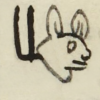Ome Tochtli (FCbk4f11r)
This painting of the simplex glyph-plus-notation stands for the date Ome Tochtli ("Two Rabbit," or 2-Rabbit). It is a day sign in the religious 260-day calendar called the tonalpohualli. It shows a three-dimensional rabbit (tochtli) in profile, facing toward the viewer's right. His fur is textured. Above his back are two small circles painted red, standing for the number two (ome). The rabbit appears on a landscape with greenery in front and behind him, and the grown is painted green. The rabbit appears to be nibbling on a blade of grass. The landscape features reveal stylistics that suggest European influence. This date is boxed, the way many dates are found. The contextualizing image shows that this box contains two dates, this one and another, Ome Calle (Two House).
Stephanie Wood
Rabbit (tochtli) and house (calli) are both year signs and day signs. To see the full page in the Digital Florentine Codex, go to: https://florentinecodex.getty.edu/book/4/folio/11r?spTexts=&nhTexts=
Stephanie Wood
1577
Jeff Haskett-Wood
tonalpohualli, años, fechas, calendarios, animales, conejos, religión indígena

ome, two, https://nahuatl.wired-humanities.org/content/ome
toch(tli), rabbit, https://nahuatl.wired-humanities.org/content/tochtli
Dos Conejo, o 2-Conejo
Stephanie Wood
Library of Congress, https://www.loc.gov/resource/gdcwdl.wdl_10615?/sp=23&st=image
The Library of Congress is unaware of any copyright or other restrictions in the World Digital Library Collection. Absent any such restrictions, these materials are free to use and reuse. Researchers are encouraged to review the source information attached to each item. If you do publish anything from this database, please cite the Visual Lexicon of Aztec Hieroglyphs.






